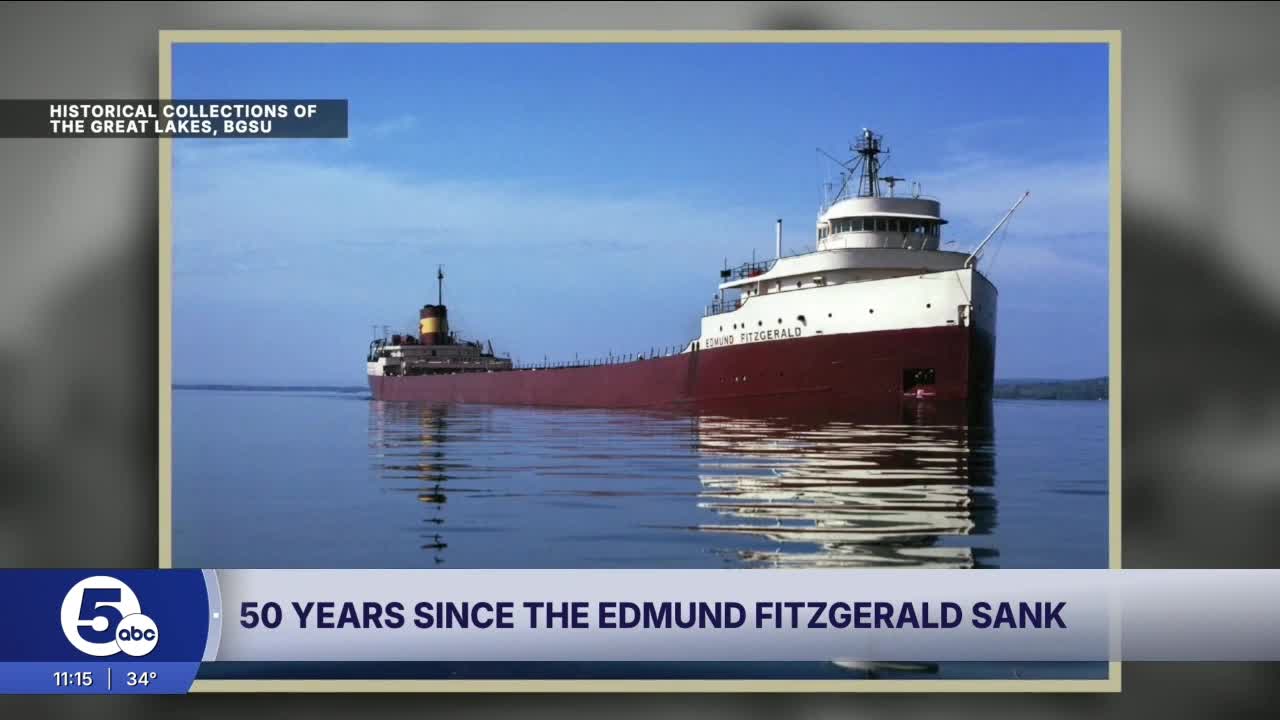CLEVELAND — The legend of the Edmund Fitzgerald ship continues to live on in the minds of the Great Lakes shipping community fifty years after it disappeared in the icy waters of Lake Superior. The famous bulk carrier was launched in 1958, setting carrying and speed records on the Great Lakes until its sinking on Nov. 10, 1975.
Director Emeritus of the National Museum of the Great Lakes Christopher Gillcrist described the sinking as the "most famous shipwreck in American waters."
Adding to the mystery of the tale is that—on the eve of the 50th anniversary of the sinking—we still do not know why the Fitzgerald sank.
Gillcrist outlined three possible theories for the cause of the sinking, but none of them can definitively claim to know what happened.
The United States Coast Guard suggested the sinking may have been caused by topside flooding or a partially open hatch allowing flooding in the cargo hold.
The National Transportation Safety Board believed one of the cargo holds may have imploded.
Others, including the Lake Carriers Association, think the Fitzgerald may have run aground near Caribou Island, opening a crack at the bottom of the boat.
"Is there anything more that people could learn that would help solve this mystery, or is it pretty much destined to forever be unsolved?" I asked.
"I really think it's destined to never be solved," Gillcrist said.
He said there were no witnesses or survivors of the Fitzgerald's sinking, and that Canada refuses to allow permits for divers or researchers to visit the wreck site, claiming it is the final resting place for 29 people.
According to Gillcrist, the Coast Guard recommended lighter cargo loads and required the use of depthometers, survival suits for crew members, and changes to the design of lifeboats as a result of the sinking. He said these steps were good for improving safety for commercial transportation on the Great Lakes, especially during the latter months of the year.
That isn't the only impact the sinking has left on the Great Lakes region. Songs like Gordon Lightfoot's The Wreck of the Edmund Fitzgerald have immortalized the name in popular culture.
"To people who are from the Great Lakes region who understand the importance of commercial shipping on the Great Lakes, even today, there's an understanding of the Edmund Fitzgerald that is kind of like genetic in their- in their souls," Gillcrist said.
Despite the allure of the mystery, Gillcrist encourages people to try to learn more about the lives of the people who were on the boat or affected by the sinking, rather than to focus on solving why the ship sank.
"Telling stories about these people and their careers and things that they did that were not even related to shipping are a way to honor their legacy and memory," he said.
The tragedy left its mark on the shipping community, stretching across Northwest and Northeast Ohio.
"It was particularly hard on Ohio and Cleveland in particular also, not only because there were serveral from Lake County and Ashtabula County and Lakewood, Ohio," Gillcrist said."The company headquarters was in Cleveland, Ohio, so you had all of those people that worked in the front office that had to, you know, that next day come into the office and realize, you know, 29 of their fellow employees had just died."
The National Museum of the Great Lakes keeps the memory of the Fitzgerald and its crew alive through its museum ship, the Colonel James M. Schoonbaker, as it has for the past 10 years.
"We do what we call the Edmund Fitzgerald comparative tour, which is to go through the boat 'cause they're very similar," Gillcrist said.
In addition to their many exhibits and tours, the museum collaborated with the Valentine Theatre to bring Meredith Moon, Lightfoot's daughter, to sing her father's song.
"She's never sung it publicly before," Gillcrist said. She performed Sunday night, the day before the anniversary.
On Nov. 10, the museum will host a panel discussion on the Fitzgerald's legacy. Participants will include guests from the shipping industry and family members of the crew.
Beyond the Fitzgerald, Gillcrist wanted to remind people that shipping is alive and well on the Great Lakes.
"Shipping is not something from the 20th or 19th century. It is something that is happening today," Gillcrist said.
The National Museum of the Great Lakes is located in Toledo, Ohio. They are open Monday through Saturday from 10 a.m. to 5 p.m. and on Sunday from 12 p.m. to 5 p.m.




